Home Ownership Dips to Nearly the Level in 1960
The U.S. home ownership rate, as recently reported by the Census Bureau, dropped to 62.9% in the second quarter of 2016, a rate about equal to the rate of 61.9% reported over a half century ago for 1960. This stagnation compares unfavorably to 1900 to 1960 when the non-farm homeownership rate increased from 36.5% to 61%.-a period encompassing rampant urbanization, immigration, and population growth. For example, the non-farm population quadrupled from about 42 million to 166 million, yet the non-farm home ownership rate increased by 67%. Except for the interruption caused by the Great Depression, the rate of increase was moderate to strong throughout the period.
How can this be? Isn’t there an alphabet soup of federal agencies-FHA, HUD, FNMA, FHLMC, GNMA, RHS, FHLBs-all with the goal of increasing homeownership by making it more “affordable”? Don’t these agencies fund or insure countless trillions of dollars in home loan lending–most with very liberal loan terms? Could it be the federal government massive liberalization of mortgage terms creates demand pressure leading to higher prices? Could it be federal, state, and local governments’ implement land use policies that constrain supply and drive prices up even further? Could it be government housing policies have made homeownership less, not more affordable or accessible?
The answer is an unequivocal yes. Since the mid-1950, liberalized federal lending policies have fueled a massive and dangerous increase in leverage-one that continues to this day. For example, in 1954 FHA loans had an average loan term of 22 years vs. 29.5 years today, an average loan-to-value of 80% vs. 97.5%, average housing debt-to-income ratio of 15% vs. 28%. Only the average borrowing cost in 1954 of 4.5% is the same as it is today. The result is today’s FHA borrower can purchase a home selling for twice as much as one with the underwriting standards in place in 1954-but without a dollar’s increase in income!
The result is that federal policies and a phalanx federal agencies have made the dream of home ownership, particularly for low-income and minority renters: less accessible, less affordable, less of a means to reliable wealth building, and more dangerous.
Home prices have risen substantially faster than incomes. Nationally, the median home price is 3.3 times median income, up from 2.9 times in 1979 and 2.0 (FHA only) in 1954. Today Los Angeles has a median home price 8.8 times median income, up from 4.2 times in 1979. Observers, including the FHA commissioner in 1963, noted: “Under conditions of limited supply, price changes tend to exceed [construction] cost changes.”
The size of new homes has nearly tripled–from 988 square feet in 1950 to 2687 square feet in 2015. This wouldn’t be a problem if the demand for larger homes came from growing real incomes not growing leverage. This problem was recognized in President Clinton’s 1995 National Homeownership Strategy (NHS), which noted: “The new entry-level or starter home is fast becoming a thing of the past. … During the [1972-1992] period, the median new home size grew from 1,385 square feet to 1,920 square feet, and prices increased accordingly.” NHS’s goal was “to promote expanded production of starter homes … for all families who want and can afford to buy.” Unfortunately, the demand-side features of the NHS promoting higher leverage worked at cross-purposes and ended up financing even larger homes, so that by 2007 and 2015 respectively the average size had increased 31% and 40% since 1992.
The now standard 30-year loan condemns FHA’s and other low-income buyers to a life of debtorship. The 20-year loan term it replaced built wealth rapidly and reliably.
Finally, it has made foreclosures commonplace again. From 1934 to 1957, FHA had an estimated 13,500 insurance claims on defaulted loans (note: in 1957 the US homeownership rate was 60%). From 1958 to 2014 FHA had an estimated 3.5 million insurance claims. This is the direct result of liberalized credit standards. Government policies have become what they were intended to cure. The FHA itself described the problem it faced in 1936-“To many people, “Mortgage” became just another word for trouble-an epitaph on the tombstone of their aspirations for home ownership.”
The answer? Market-rate, economical housing, along with incentives to reduce leverage so as to reliably build wealth. This starts with bending the local and state government regulatory cost curve so as to increase the supply of market rate, economical housing. This is housing that largely serves service, light manufacturing and entry-level workers. Such housing is economical by design, making it naturally affordable, not expensive housing made affordable by government subsidy. Unleashing private enterprise will expand supply, thereby allowing supply and demand to reach equilibrium at lower and more sustainable price points. Undoubtedly the greatest beneficiaries will be low- and moderate-income and minority households.
EDITORS NOTE: This column originally appeared on RealClearMarkets.com.



Leave a Reply
Want to join the discussion?Feel free to contribute!